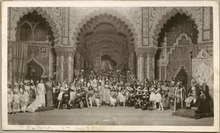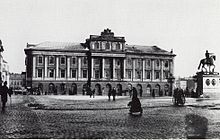Royal Opera (Stockholm)
The Royal Opera ( Swedish Kungliga Operan ) is the Swedish State Opera . In order to distinguish it from other royal opera houses , it is often called the “Royal Swedish National Opera” in German-speaking countries, and Royal Swedish Opera in English (also in the opera's international artist contracts) .
It is located in the central district of Norrmalm of the capital Stockholm in a historical architectural ensemble on Gustav Adolfs Torg ( Gustav-Adolf-Platz ), directly opposite the Erbfürstenpalais ( Arvfurstens palats , today's Foreign Ministry ) on the north bank of the Norrström , over which the bridge is Norrbro with the Royal Stockholm Palace and the Reichstag (Riksdagshuset) connects. At the back is the Kungsträdgården (King's Garden), one of the oldest city parks in Stockholm. The Sager House , the official residence of the Swedish Prime Minister, is also in the immediate vicinity .
Facts and history


Around 60 percent of operas and 40 percent of ballet are shown in the Kungliga Operan . There are around 15 to 20 opera productions and around 5 ballet productions in the repertoire per season .
The Royal Ballet, Kungliga Ballets , and the Royal Court Orchestra , Kungliga Hovkapellet , are located in the same building . There is a restaurant in the cellars of the opera.
The Royal Swedish National Opera plays an important role in the cultural history of Sweden, as it and its predecessor institutions reflect the respective artistic style and zeitgeist through the direct cultural-political impulses and influences of the respective rulers (namely Gustav Wasa , Kristina , Gustav III , Oskar II ) which radiated representative of the respective time from the capital to the wider area of the country.
Its history is also closely linked to its - much older - "house orchestra", the Royal Court Orchestra (Kungliga Hovkapellet) , which has been heavily promoted by the respective royal rulers since its foundation in the 16th century under King Gustav Wasa, as well as composers and band masters attracted internationally, which in turn had a formative effect on opera. They include a number of German musicians, including several members of the Düben family as well as Johann Gottlieb Naumann , Georg Joseph Vogler and Joseph Martin Kraus .
The beginning of performances under Gustav III , King of Sweden , in Bollhuset on January 18, 1773 is seen as the hour of birth of Swedish opera . It was then called the Royal Theater (Kungliga Teatern) . However, in addition to the opera and ballet performances, plays were also shown. However, the first opera house did not open until 1782.
After 15 years Gustav III. In 1788, the Royal Dramatic Theater was also split off from the existing Royal Theater (Kungliga Teatern) at a separate venue behind the opera house on Kungsträdgården , in order to spatially separate music and spoken theater. Since that split off, the newly established Royal Dramatic Theater has been the venue for spoken drama without exception. The Royal Theater, however, remained as a pure opera house for opera and ballet and has been called Kungliga Operan (Royal Opera) since 1997 . In its history, the royal opera received two buildings in the same place in chronological order through the respective kings; the second is today's Kungliga Operan (Royal Swedish National Opera).
The first royal opera house
King Gustav III campaigned for the opera and had an opera house built on Gustav-Adolf-Platz for the first time in 1775 according to plans by the architect Carl Fredrik Adelcrantz . At the inauguration on September 30, 1782, the Swedish opera Cora och Alonzo by Johann Gottlieb Naumann was performed. Gustav III was murdered on March 16, 1792 in the Royal Opera House at a masked ball. This event was covered by Giuseppe Verdi almost 70 years later in his opera Un ballo in maschera (A masked ball) .
As an exact replica of the opera house, King Gustav's sister Princess Sofia Albertina had the Palace of the Hereditary Prince ( Arvfurstens palats ) built directly opposite the opera house on Gustav-Adolfs-Platz between 1783 and 1794 according to plans by Erik Palmstedt , so that there was architectural symmetry . The original architecture of the first opera house has been preserved to this day, after that had to give way for a subsequent building in 1891. Today the Foreign Ministry is located in the Arvfurstens palats .
The second Royal Opera House
After over a hundred years, the first opera house was demolished in 1891 because it was worn out and too small. The ensemble was housed in the Swedish Theater (Svenska Teatern) on Blasieholmen for the seven years from 1892 to 1898 that the new building lasted . The new opera house was built in the neoclassical style by Axel Anderberg on the same spot where the old house was. It is the current opera house of the Royal Opera.
The inauguration took place on September 19, 1898 by King Oskar II . Was played Adolf Fredrik Lindblad Opera Frondörerna (The rebels) . The hall has about 1100 seats; there is a two-ton chandelier on the ceiling . The so-called Gold foyer (Guldfoajé) (at the level of the first lodges-rank on the first floor above the main entrance area) is complex decorated with gold and mirrors and measures 28 x 8 meters. The new building has also had a restaurant since 1895 and a bar since 1905. The exterior color of the building corresponds to that of the Royal Stockholm Palace on the opposite bank of the Norrstrom . For the family of the Swedish King Carl XVI. The royal box in the first tier above the orchestra pit and a private room in the opera house are reserved for Gustaf .
Since 1935, the building has been a listed building as Byggnadsminne .
Ensemble, artist and artistic director

The famous Swedish singers who emerged from the opera house ensemble include Jussi Björling , Gösta Winbergh , Nicolai Gedda , Peter Mattei , Jenny Lind , Birgit Nilsson , Elisabeth Söderström , Anne Sofie von Otter , Solveig Kringlebotn , Miah Persson , Katarina Dalayman and Nina Stemme . The soprano Erika Sunnegårdh has made several guest appearances at the opera house in her hometown.
To recognize special artistic achievements, selected members of the vocal ensemble are awarded the title Hovsångare (male) or Hovsångerska (female) (“Royal Court Opera Singer ”) by the Swedish King , which is comparable to the German title of Kammersänger .
The history of the establishment of the opera house orchestra , the Royal Court Orchestra (Kungliga Hovkapellet) , dates back to 1526. The orchestra is thus one of the oldest in Europe.
The Royal Ballet (Kungliga Baletten) was created by Gustav III. founded in 1773.
The current artistic director of the Royal Stockholm Opera is the Swedish mezzo-soprano Birgitta Svendén.
Web links
- Official website of the Royal Stockholm Opera (Swedish, English)
- Official website of the Royal Court Orchestra (Swedish, English)
- Kungliga Operan at Operabase (productions, artists and calendar)
- Entry in the bebyggelseregistret des Riksantikvarieämbetet (Swedish)
Individual evidence
- ^ Gunilla Petersén: From the History of the Royal Court Orchestra 1526-2007.
Coordinates: 59 ° 19 ′ 47 ″ N , 18 ° 4 ′ 14 ″ E



